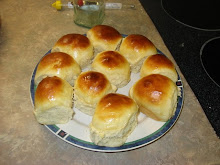
Basil Bread
Ingredients:
1/2 cube fresh yeast
1 cup plus 2 1/2 Tblsp. warm water
3 1/2 Tblsp. olive oil
2 1/4 tsp. salt
1 tsp. sugar
3/4 cup tightly packed basil leaves (I like the purple ones best)
5 cups all-purpose flour
Method:
1. Rinse and carefully dry the basil leaves. Chop them into fine ribbons.
2. In a medium bowl, dissolve the yeast in all the water.
3. Add the sugar; stir to dissolve. Add the oil, salt, and chopped basil leaves. Stir it all up.
4. Add half-cups of flour, stirring well each time, till you have a loose dough. This should take 4 to 4 1/2 cups. Mix well.
5. Cover with plastic wrap and put in the fridge for 6-8 hours. It will rise and be spongy by morning.
6. Next day, deflate the dough by stirring it. Sprinkle more flour in, first stirring, then kneading lightly, till the dough is stiff. Let it sit by itself for 15 minutes to absorb the flour.
7. Add the rest of the flour – up to 5 cups total. Knead again, lightly, and form a ball of the dough. Dribble a little olive oil over it, then turn it around in the bowl a few times. Drape a kitchen towel over the bowl, and leave the dough to rise for 45 minutes at room temperature.
8. Preheat the oven to 350 F, 180 C, about 20 minutes before you plan to bake. At the same time, shape your loaf and put it to rise once again on a sheet of baking paper. It will be very light and bubbly when it’s ready to bake.
9. Handle the loaf gently, so as not to deflate it. Bake it for 30 minutes. When the crust is golden and sturdy, turn the loaf upside down to finish baking, 10-15 minutes more.

